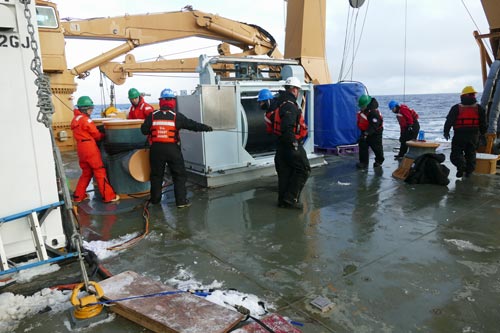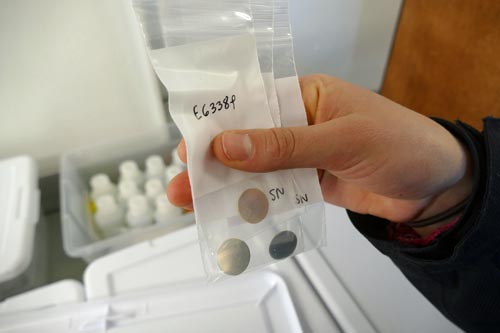Cruise Day 53
Speed 8.5 knots (kts)
Course 31° (NNE)
Location Canada Basin, ~240 nm north of Barrow, Alaska
Depth 3883 m
GO DEEPER DISCUSSION: (see previous journal for the questions.)
Ocean acidification due to increasing atmospheric carbon dioxide concentrations is a threat on two fronts. First of all, many kinds of plankton cannot properly grow their shells if the pH of the water they are living in gets too low. Once its buffering ability has been depleted, ocean water pH can drop into these inhospitable levels as more CO2 is absorbed. (Carbon dioxide reacts in water to make carbonic acid.) Secondly, our oceans have been absorbing about half of the excess CO2 released into the atmosphere by human activities. But as pH drops, seawater can’t absorb as much CO2 and so atmospheric levels of this greenhouse gas could climb even faster as seawater loses its ability to absorb carbon dioxide.
TODAY’S JOURNAL:
The wind and waves put us into a bit of difficulty yesterday, causing some damage on our two Vectran cables (the trace-metal clean cables used for McClane pumps and the GEOTRACES rosette.) The issues arose after strong winds caused the Healy to drift significantly sideways, with the cables on each cast angling out sideways and getting abraded on the cheeks (sides) of the A-frame block or even on the aft A-frame cable. Instead of continuing to try sampling, the decision was made to suspend science operations yesterday afternoon and give the weather some time to blow itself out. At noon today we started up again with ODF rosette sampling from the starboard A-frame while the damaged cables are assessed and repaired. As I’ve seen before, the Healy crew and science team are both equipped with the tools and expertise to deal with this kind of situation so I’ll bet we’ll be back to full business soon.

During the lull in sampling I had the chance to visit with Katie Krupp, Graduate Research Assistant at Wayne State University in Detroit, Michigan. Katie is tasked with collecting samples of polonium-210, a naturally occurring radioactive isotope, and its parent lead-210. Both of these unstable isotopes are derived from the decay of uranium-238 , which occurs naturally in many Earth systems. While uranium-238 is the most stable form of the element (with a half life of almost 4.5 billion years), it does slowly decay into radon, a radioactive gas that gets distributed in the atmosphere. This in turn can decay into lead-210, which has an affinity for atmospheric particles. These can reach the ocean surface by direct deposition or if they are carried down by precipitation. Lead-210 has a moderate half-life of a little over 22 years, but the polonium-210 it decays into has only a 138-day half life.

The main significance for oceanography is that polonium is easily scavenged by organic carbon particles in the ocean. (That’s kind of a fancy way of saying that polonium sticks to things like phytoplankton.) Thus, polonium offers a way to trace particulate organic carbon through the water column. Measuring the ratio of lead-210 to polonium-210 can also be used to estimate the age of snow and ice layers from ice station samples.
To collect polonium-210, 20 liters of water from each sampling depth is needed (two full Niskin bottles from the ODF 36-bottle rosette.) Katie adds iron hydroxide and hydrochloric acid to each sample. Polonium is scavenged by the iron hydroxide, and the acid keeps it dissolved. She also spikes the solution with a known amount of polonium-209. After sufficient time, the pH is raised, causing the polonium-enriched iron hydroxide to precipitate out of the solution. The concentrated material is filtered out and re-dissolved in small Teflon beakers. A silver disc called a planchet is left in each sample beaker for about 20 hours. The polonium in the sample electroplates itself onto the silver planchets, which are analyzed later at a lab equipped with alpha particle detectors. Polonium-209 has a different radioactive signature than polonium-210, and by comparing how much of the original known quantity of polonium-209 is recovered an efficiency can be calculated. By applying this efficiency to the polonium-210 count, a concentration value for the water sample in question can be determined.


Lead-210 levels aren’t directly measured, but can be calculated by re-measuring polonium-210 in the same water samples 6 to 8 months later. A value for lead-210 can be determined since polonium-210 is created by the decay of lead-210 at a known rate.
While working with radioactive elements like polonium may seem spooky, the levels of the element in seawater are fleetingly low. Katie indicated that there is likely more polonium in a handful of dirt from one’s back yard than in the samples she is working with. That’s good to know, Thanks, Katie!
GO DEEPER!
Many readers of this journal may have had their residence tested for radon, or even have a radon mitigation system in place. These systems typically have blowers that vent air from the foundation of their residence. Why is radon a potential health hazard?
Aloft Con web cam updated every hour
Healy Track
That's all for now. Best- Bill


Comments